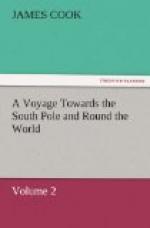The bay hath twenty leagues sea-coast, six on the east side, which lies in the direction of S. half W. and N. half E., two at the head, and twelve on the west side, the direction of which is S. by E. and N. by W., from the head down to two-thirds of its length, and then N.W. by N. to the N.W. point. The two points which form the entrance, lie in the direction of S. 53 deg. E., and N. 53 deg. W., from each other, distant ten leagues. The bay is every where free from danger, and of an unfathomable depth, except near the shores, which are for the most part low. This, however, is only a very narrow strip between the sea-shore and the foot of the hills; for the bay, as well as the flat land at the head of it, is bounded on each side by a ridge of hills, one of which, that to the west, is very high and double, extending the whole length of the island. An uncommonly luxuriant vegetation was every where to be seen; the sides of the hills were chequered with plantations; and every valley watered by a stream. Of all the productions of nature this country was adorned with, the cocoa-nut trees were the most conspicuous. The columns of smoke we saw by day, and fires by night all over the country, led us to believe that it is well inhabited and very fertile. The east point of this bay, which I name Cape Quiros, in memory of its first discoverer, is situated in latitude 14 deg. 56’ S., longitude 167 deg. 13’ E. The N.W. point, which I named Cape Cumberland, in honour of his Royal Highness the Duke, lies in the latitude of 14 deg. 38’ 45” S., longitude 166 deg. 49’ 1/2 E., and is the N.W. extremity of this archipelago; for, after doubling it, we found the coast to trend gradually round to the S. and S.S.E.
On the 28th and 29th, we had light airs and calms, so that we advanced but little. In this time, we took every opportunity, when the horizon was clearer than usual, to look out for more land, but none was seen. By Quiros’s track to the north, after leaving the bay above-mentioned, it seems probable that there is none nearer than Queen Charlotte’s Island, discovered by Captain Carteret, which lies about ninety leagues N.N.W. from Cape Cumberland, and I take to be the same with Quiros’s Santa Cruz.
On the 30th, the calm was succeeded by a fresh breeze at S.S.E. which enabled us to ply up the coast. At noon we observed in 15 deg. 20’; afterwards we stretched in east, to within a mile of the shore, and then tacked in seventy-five fathoms, before a sandy flat, on which several of the natives made their appearance. We observed on the sides of the hills, several plantations that were laid out by line, and fenced round.
On the 31st, at noon, the S. or S.W. point of the island bore N. 62 deg. E., distant four leagues. This forms the N.W. point of what I call Bougainville’s Passage; the N.E. point at this time bore N. 85 deg. E., and the N.W. end of Mallicollo from S. 54 deg. E. to S. 72 deg. E. Latitude observed 15 deg. 45’ S. In the afternoon, in stretching to the east, we weathered the S.S.W. point of the island, from which the coast trends east, northerly. It is low, and seemed to form some creeks or coves; and, as we got farther into the passage, we perceived some small low isles lying along it, which seemed to extend behind St Bartholomew Island.




